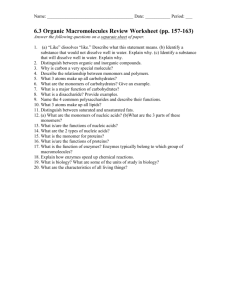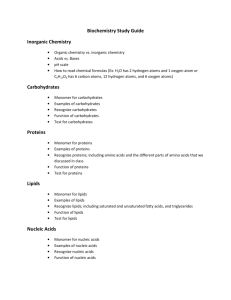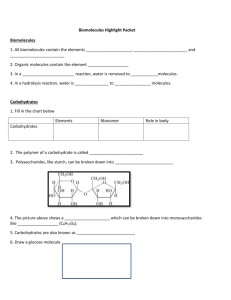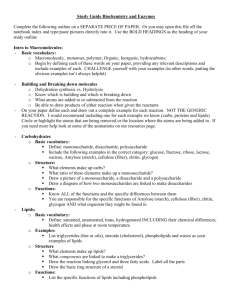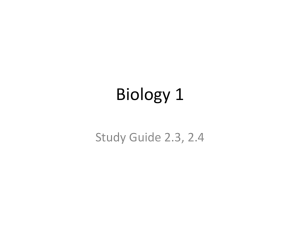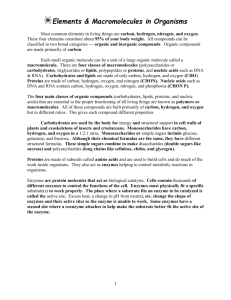Exam Study Guide for Macromolecules (sec. 2
advertisement
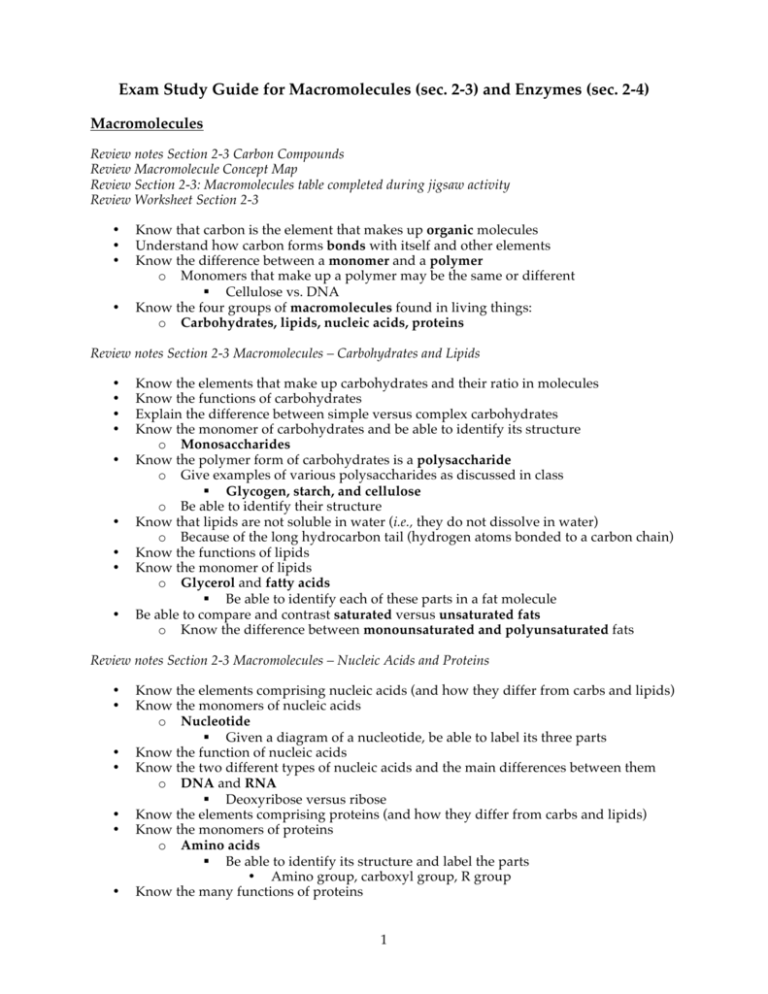
Exam Study Guide for Macromolecules (sec. 2-3) and Enzymes (sec. 2-4) Macromolecules Review notes Section 2-3 Carbon Compounds Review Macromolecule Concept Map Review Section 2-3: Macromolecules table completed during jigsaw activity Review Worksheet Section 2-3 • • • • Know that carbon is the element that makes up organic molecules Understand how carbon forms bonds with itself and other elements Know the difference between a monomer and a polymer o Monomers that make up a polymer may be the same or different Cellulose vs. DNA Know the four groups of macromolecules found in living things: o Carbohydrates, lipids, nucleic acids, proteins Review notes Section 2-3 Macromolecules – Carbohydrates and Lipids • • • • • • • • • Know the elements that make up carbohydrates and their ratio in molecules Know the functions of carbohydrates Explain the difference between simple versus complex carbohydrates Know the monomer of carbohydrates and be able to identify its structure o Monosaccharides Know the polymer form of carbohydrates is a polysaccharide o Give examples of various polysaccharides as discussed in class Glycogen, starch, and cellulose o Be able to identify their structure Know that lipids are not soluble in water (i.e., they do not dissolve in water) o Because of the long hydrocarbon tail (hydrogen atoms bonded to a carbon chain) Know the functions of lipids Know the monomer of lipids o Glycerol and fatty acids Be able to identify each of these parts in a fat molecule Be able to compare and contrast saturated versus unsaturated fats o Know the difference between monounsaturated and polyunsaturated fats Review notes Section 2-3 Macromolecules – Nucleic Acids and Proteins • • • • • • • Know the elements comprising nucleic acids (and how they differ from carbs and lipids) Know the monomers of nucleic acids o Nucleotide Given a diagram of a nucleotide, be able to label its three parts Know the function of nucleic acids Know the two different types of nucleic acids and the main differences between them o DNA and RNA Deoxyribose versus ribose Know the elements comprising proteins (and how they differ from carbs and lipids) Know the monomers of proteins o Amino acids Be able to identify its structure and label the parts • Amino group, carboxyl group, R group Know the many functions of proteins 1 • • Understand that proteins can have up to four levels of organization o Most have tertiary, some have quaternary Understand that protein structure determines protein function o A change in protein structure causes the protein’s function to decrease or even stop Enzymes Review notes, worksheets, and labs: • Notes Section 2-4 Chemical Reactions and Enzymes • Coloring worksheet “Chapter 2-7: Enzymes” – both the text and the diagrams • Toothpickase Activity • Characteristics of Enzyme Function: Liver Lab • • • • • • • • • • • • Understand that chemical reactions are necessary for life to exist. It is how living things get the substances needed for all of their activities. Recognize that some chemical reactions are slow and some are quick o Slow: formation of rust (iron oxide) o Fast: hydrogen gas ignited with oxygen Be able to define reactant and product Be able to explain the carbon dioxide (CO2) example of a chemical reaction o Recognize both chemical equations as given in the section 2-4 notes Know that some chemical reactions release energy and some absorb (take in) energy o Understand why living things need to obtain energy (food) Know that overcoming activation energy is necessary for some chemical reactions to get started o Be able to interpret graphs like the ones given on pages 3 & 4 in your notes Describe what catalysts are and why they are imperative for life to exist Understand the function of enzymes and their importance to living things Understand that enzymes are very specific to the reaction they catalyze o Usually only one substrate per enzyme o Enzymes end in –ase o Name is derived from the reaction they catalyze Know the mechanism by which enzymes catalyze reactions o The figure at the bottom of page 5 in your notes is extremely important! Be able to label the enzyme, substrates, active site, enzyme-substrate complex, and products in a similar figure Be able to define substrate, product, enzyme-substrate complex, and active site Understand that enzymes are affected by changes in their environment o They only work well in a particular set of conditions o Are affected by changes in pH and temperature Which pH and temperatures work well for most body enzymes? 2
